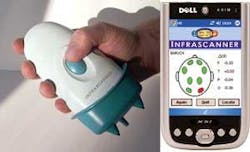MEDICAL SENSING: Inexpensive handheld tool detects brain injuries in the field
About two million Americans suffer concussions each year, and too often the result is severe neurological damage or death. “People often don’t realize when they’ve had a concussion, because there is no loss of consciousness,” says Liz Giordano, CEO of the Head Injury Association (Commack, NY). Failure to detect and treat intracranial hematoma (brain bleeding) within the first hour can have catastrophic effects and computed tomography (CT), the gold standard for diagnosing and pinpointing brain bleeding, is often unavailable in places like ski resorts or on the battlefield.
At about 1% of the cost of a CT scanner, a portable near-IR (NIR) device by InfraScan (Philadelphia, PA) is now awaiting FDA approval—though it’s already received Giordano’s approval. Carried by emergency medical technicians, the tool could enable diagnosis of head-injury patients much earlier and avert tragedies. InfraScan is a start-up company spearheaded by legendary laser-medicine pioneer and National Medal of Science winner Britton Chance—along with Claudia Robertson from the Baylor College of Medicine (Houston, TX) and an entrepreneurial team from Drexel University (Philadelphia, PA).
Differential light absorption
The Infrascanner takes just two minutes to scan a person’s head. “The system is used to measure all four major brain quadrants (frontal, temporal, parietal and occipital) on the left and the right sides of the head, for a total of eight measurements,” said Baruch Ben Dor, InfraScan president and CEO. The battery-operated unit evaluates the differential light absorption of the left versus right brain. Normally, light absorption is symmetrical. But when the brain suffers a hematoma, light absorption is increased while the reflected component is decreased in the affected area. The system presents its data to the operator through a graphic red/green display and a numerical value of the difference in optical density between the left and the right sides—which is proportional to the amount of bleeding.
The setup consists of two parts: a sensor system and a commercially available personal digital assistant (PDA) that runs dedicated software. The sensor includes a Class I 808-nm-emitting diode laser placed 1.5 in. away from a silicon light detector, which is covered by an NIR bandpass optical filter. The laser illuminates the tissue by way of an optical fiber, and the detector reads the signal through a second fiber. The separation between source and detector allows measurement of NIR absorbance in a volume of tissue about 3/5 in. wide by just over an inch deep. The system then digitizes the signal and transmits it wirelessly (via Bluetooth) to the PDA. Operators are trained to use the device, but software in the PDA also checks the signals and can alert the user if he or she makes a common mistake. And because the system is contained in a handheld device, it is possible to complete a scan when a fallen patient cannot be moved.
The Infrascanner received Europe’s CE mark this past fall, and recently completed multicenter clinical trials in the U.S. and abroad. Now it is awaiting FDA clearance.
In addition to its field application, the technology shows promise for repeated scanning of patients in intensive-care units to catch delayed hematomas. This application is attractive because CT scans are not only expensive, but also known to introduce high doses of radiation in patients. The technology could be used to monitor patients with strokes and other blood-flow disorders.

Barbara Gefvert | Editor-in-Chief, BioOptics World (2008-2020)
Barbara G. Gefvert has been a science and technology editor and writer since 1987, and served as editor in chief on multiple publications, including Sensors magazine for nearly a decade.
